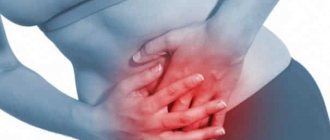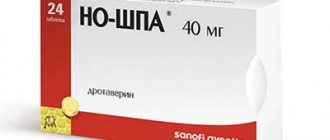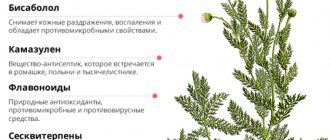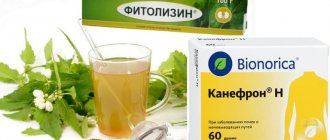Paracetamol is a popular drug to combat the symptoms of rapidly developing colds. It is an indispensable assistant for extreme body hyperthermia, when the body temperature has exceeded 38.5 degrees. In addition to antipyretic effects, the medication also has analgesic properties. It is prescribed for mild or moderate toothache, myalgia and arthralgia, but can it be used for abdominal pain during menstrual bleeding? This pressing issue should be examined in detail, since many women are in search of the ideal medicine to relieve pain during menstrual periods - something that will help quickly and be inexpensive.
Is it possible to take paracetamol for algodismenorrhea?
When painful menstrual bleeding begins, the lower abdomen begins to ache, severe cramps occur, and the pain can radiate to the stomach, lower back or thigh. Tolerating such unpleasant sensations is painful and harmful, so it is better to take a painkiller. Paracetamol is indeed allowed to be taken for algodismenorrhea, but it only helps with mild to moderate intensity syndrome. This means that it is unlikely to help women with severe pain, and even if it does work, it will only temporarily ease the discomfort without completely eliminating it. There is also an opinion that the medication can slow down the flow of menstrual blood - just take one tablet and the intensity of the discharge will decrease. True, this fact is not fully proven.
Many women prefer to take paracetamol because it differs from its analogues in the speed of its effect. The drug, once in the stomach, is almost completely absorbed within half an hour, and no later than an hour later it exhibits its full activity. The approximate duration of the analgesic effect is 4 hours. You can safely drink the drug 3-4 times a day, 1-2 tablets. The maximum single dose is 1 gram, and the daily dose is 4 grams. Tablets are sold in dosages of 200 mg (for children), 375 mg and 500 mg. It is best to take the medicine an hour after eating so that the effect manifests itself as quickly as possible. If a woman suffers really seriously with severe pain every month, then in this case you need to contact a gynecologist for treatment. You can take the medicine for no more than 3-5 days in a row.
According to WHO recommendations, for uncomplicated algodismenorrhea, it is best to use drugs based on purified paracetamol. After all, if you compare it with other non-steroidal anti-inflammatory drugs, it turns out that it has a number of advantages:
- Does not irritate the gastric mucosa
- Does not increase bleeding or increase menstrual volume (unlike aspirin)
- It is normally combined with hormonal drugs, which are often prescribed for gynecological purposes.
Nonsteroidal anti-inflammatory drugs
Nonsteroidal anti-inflammatory drugs act in several ways: they help relieve pain and help treat inflammation, and reduce the amount of prostaglandins in the blood.
These medications should only be prescribed by a doctor, and in order to be effective, it is best to take them 2 days before your period appears. They are also applicable for women who have contraindications to hormonal pills.
Antispasmodics
Pain similar to contractions in the groin area is caused by spasms of the smooth muscles of the uterus. Muscle contraction occurs due to the influence of prostaglandin hormones, the amount of which increases during menstruation.
By eliminating pain, antispasmodics relieve spasms of smooth muscles. These painkillers can be taken independently only in small doses and strictly according to the instructions.
List of antispasmodics:
- Papaverine (in the form of pills or suppositories for rectal use)
. Pills are taken 3-4 times a day, suppositories - 2-3 times a day. Contraindications: eye diseases, liver diseases, heart defects. - No-spa (active component - drotaverine)
.
No-shpa is used 2-3 times a day or No-shpa Forte twice a day. No-spa is also produced as a solution for injections. Contraindications: complex dysfunction of the heart, liver, kidneys, allergy to lactose. No-spa is prohibited for the lactation period. No-spa as a way to get rid of dysmenorrhea has several analogues: Spasmonet, Spakovin, Unispaz
(in association with Paracetamol and Codeine). The hypothetical side effect of No-spa is tachycardia, fever, sweating, allergic reaction on the skin. - Halidor (active ingredient - bencyclane)
. Sedative and analgesic. Use three times a day. Not recommended for complex insufficiency of the respiratory, cardiovascular, and nervous systems. Also for kidney and liver diseases, breastfeeding. - Buscopan (active component - hyoscine butyl bromide).
Available in the form of tablets and suppositories. Take tablets three times a day, suppositories - 4 r. Not recommended for myasthenia gravis, eye diseases, megacolon, swelling of the respiratory system, atherosclerosis.
Papaverine
No-Shpa
Buscopan
Galidor
Spasmonet
Painkillers from the antispasmodic group have some negative effects:
migraines and dizziness, disorders in the digestive system (diarrhea, constipation), allergies to the components of the medication.
The most effective method is the use of No-shpa. These tablets are perfectly compatible with other antispasmodics. Therapeutic course - up to 2 days or until discomfort is completely eliminated.
The YouTube ID of 2Zi—DTLIZw is invalid.
Analgesics
Most applicable during menstruation. With the help of analgesics, you can get rid of the pain symptom and the root cause of poor health.
Analgin (Baralgin, Tempalgin)
Forms of production - tablets, suppositories, injection solutions; The active ingredient is metamizole sodium.
This medication is effective for
:
- pain syndrome,
- due to hepatic and renal colic,
- myalgia,
- headaches,
- teeth,
- increased temperature due to infectious and inflammatory diseases.
The course is 1 tablet up to 3 times a day.
- liver failure,
- kidney,
- low blood clotting,
- increased sensitivity to the components of the drug.
Aspirin (Thrombo, acetylsalicylic acid)
Active ingredient: acetylsalicylic acid
.
In order to eliminate dysmenorrhea, use 2 pills, up to 4 doses per day.
Do not take if:
- ulcers and gastritis,
- bleeding diathesis,
- respiratory diseases,
- individual intolerance to ASA and other auxiliary components,
- children under 15 years old.
Novalgin (Saridon, Caffetin, Safiston, Flucomp, Extratab)
The active ingredient is propyphenazone, paracetamol, caffeine.
A multi-component good drug used in the treatment of mild and moderate pain with various underlying causes (initial dysmenorrhea, headache, myalgia, arthralgia, etc.), increased body temperature.
Take 1 pill, up to 1-3 times a day.
Produced in tablets and capsules.
A multi-component medicine, the structure of which includes:
paracetamol, naproxen, caffeine.
The remedy is prescribed to relieve ailments and colds.
- gastritis and ulcers,
- tachycardia and arrhythmia,
- diseases of the cardiovascular system, etc.
Combination drugs with paracetamol for algodismenorrhea
Combined non-steroidal anti-inflammatory drugs with an analgesic effect have good potency for severe menstrual pain. The most popular medication in this category is solpadenine. This drug is a combination of paracetamol, caffeine and codeine. If everything is known about the properties of the first medication, then caffeine acts as an enhancer, as it improves the analgesic effect of non-steroidal analgesics, and codeine is a powerful painkiller of narcotic origin, a derivative of morphine (opiates). Just one tablet and the severe pain will go away for a long time. True, there is one drawback - now in Russia solpadeine cannot be sold without a prescription, but if a woman has really severe algomenorrhea, then she can make an appointment with a doctor, and if the doctor deems it necessary, he will write a prescription for this medication.
Another powerful painkiller that contains paracetamol is pentalgin-n. One tablet contains, in addition to one active ingredient - caffeine, sodium naproxen, pheniramine maleate, drotaverine hydrochloride. It is with this trade name that you can purchase pentalgin-n without a prescription, because it does not contain codeine. All other analogs of pentalgin, which contain an opiate analgesic, require a prescription.
The over-the-counter alternative is good for women suffering from menstrual pain. Naproxen sodium has a pronounced analgesic and anti-inflammatory effect, caffeine removes water, relieves swelling, enhances the active ingredients, pheniramine soothes and weakens spasms, and drotaverine (no-spa) is a powerful antispasmodic, which is primarily indicated for menstrual pain, as painful sensations During menstruation, these are severe cramps.
Folk remedies
When pain on women's days causes anxiety, you can use alternative medicine methods:
It is important to keep in mind that in case of concomitant diseases of the genitourinary system, it is necessary to contact a specialist.
Painful sensations in the lower abdomen that cause discomfort during menstruation are familiar to many women. As a rule, they are easily tolerated and do not force you to change your usual daily routine, but sometimes this cannot be achieved without the help of medications. In such cases, a woman needs to be prepared and know what is right for her, so that pills for period pain perform their function and do not cause complications.
Other analogues for the treatment of algodismenorrhea
The most powerful non-narcotic analgesic that is sold without a prescription is ketanov. As statistics show, many women often resort to it because it is able to relieve the most severe algomenorrhea. Diclofenac is also a strong remedy; it is a weaker analgesic, but it has pronounced anti-inflammatory properties. If a woman has a sensitive stomach, then it is better to give preference to more modern drugs - Nise, Nimesil, meloxicam.
55% of women agree that menstruation brings mixed feelings at the same time. But the most unpleasant of them is the discomfort and pain experienced by a representative of the fair half of humanity. In most cases, this is provoked by anatomical features. But there are also cases when pain occurs due to diseases of the reproductive system. In both options, the woman, first of all, is looking for a way out. And he finds it in the form of dosage forms that can reduce pain during menstruation. Tablets or other medicine that relieve pain during menstruation not only reduce cramps or severe pain, but also help remove inflammation.
Examination and treatment
Every woman always needs to know about the main reason for the occurrence of pain, since such a manifestation can be a signal from the body about pathological processes, sometimes irreversible - a serious danger to the organs of the reproductive system or the life of the patient.
Dysmenorrhea can become a symptom of diseases of the fallopian tubes, endometriosis, and various tumors. Such manifestations are diagnosed in every third patient with pain during menstruation. In order to protect your own health from complex pathologies, it is necessary to visit the gynecological office at least once every six months and systematically conduct ultrasound diagnostics.
About menstruation
Pain during the onset of menstruation occurs in every second woman. It can be strong or weak, accompanied by cramps or dizziness. This depends not only on the beauty’s body, but also on other factors:
- what is the pain threshold;
- illnesses that have lasted for several months;
- presence of chronic diseases;
- ailments of the reproductive system;
- number of births and terminations of pregnancy.
Pain during menstruation occurs in every second woman
Naturally, pills for pain during menstruation will help with any factors, but they will not help solve the problem. Several drugs have been created that help reduce and completely eliminate pain during monthly bleeding. But all of them will not provide a complete cure, and the pain will continue regularly. Therefore, doctors recommend not trying to eliminate problems on your own, but seeking advice from specialists. After all, quite often No-Spa for menstruation or Ibuprofen for menstrual pain only mask serious health problems.
But this does not mean that pills for menstrual pain should not be taken. You just need to urgently seek help to identify the factor and provocateur of pain. Still, such sensations always cause additional stress for the whole body and pose a threat to health.
Causes of pain during menstruation
Dysmenorrhea (this is the scientific name for pain during menstruation) most often occurs in teenage girls and nulliparous women. Its cause may be hereditary predisposition, irregular sex life, unbalanced diet.
Poor health during menstruation can also be caused by a lack of vitamins in the body, hormonal disorders, and the use of intrauterine devices. Painful periods are accompanied by heavy discharge with the formation of blood clots.
Is it possible and necessary to reduce pain?
Tablets for abdominal pain during menstruation significantly reduce algomenorrhea and dysmenorrhea. Or simply put, MPS (menstrual pain syndrome). This process is caused by an excess of accumulated prostaglandin. This substance is an enzymatic substance and promotes endometrial rejection. There is an increased contraction of the uterine muscles. All this serves as a provocateur for increasing or decreasing pain or spasms in the uterus. The best pain reliever for menstruation not only relieves pain and relaxes, but controls the production of the enzyme. The rest relieve spasms.
But is it worth using pills for period pain? Every specialist in the field of gynecology will answer that it is definitely necessary to use it. But only the first days. Then go to the hospital for diagnosis and selection of dosage forms.
Being afraid of a visit to the doctor, as well as starting to suspect a disease on your own and treat it, is life-threatening. At the same time, both stomach pills during menstruation and injections are used to relieve pain.
Tablet form of pain relief
Painkillers for menstruation can be compiled into a list. From fast-acting drugs to simple, short-acting drugs. They are conventionally classified into groups:
| Drug class | Properties |
| Antispasmodics (Papaverine, Drotaverine, No-shpa) | They dilate the pelvic vessels and increase blood flow to the uterus. No-spa is ideal for relieving spasmodic pain during menstruation. But if you doubt whether No-shpa helps with menstruation, then women will think about Papaverine or Drotaverine. Drugs such as Papaverine for menstrual pain will work just as well as pills for cramps during menstruation. They can be called analogues. Reception is carried out up to three times a day at equal intervals. Used to relieve minor sensations |
| Analgesics that do not require a prescription | What pills can you take during menstruation if your stomach hurts with analgesic properties? If antispasmodics are suitable for literally everyone, then this class is selected individually. The fact that tablets for painful periods of this type reduce body temperature and stabilize blood pressure is taken into account. These drugs include: |
- analgin and teraflu;
- novalgin and efferalgan;
- saphiston and panadol;
- baralgin and calpol
Types of pain on critical days
There are two types of pain, different in symptoms:
You need to worry in the following situations:
- Medicines for abdominal pain are not effective;
- increased amount of bleeding, many clots;
- extreme pain, vomiting, nausea, and other unusual symptoms.
With such symptoms, you need to contact a specialist. Sometimes the cause is the onset of spontaneous abortion, which is mistaken for menstruation. Neglecting these manifestations and delaying seeking help threatens deterioration of health, and sometimes even life.
Abdominal pain
The main reason why pain in the lower groin area occurs on women's days is hormonal changes and uterine contractions. The increased presence of prostaglandins stimulates uterine contractions. At the same time, the tension of the uterus and, accordingly, pain sensations depend on the amount of these hormones.
Incorrect location of the uterus, possibly displacement of the organ backwards, and compression of the nerve endings. When a female representative has such a body structure, discomfort is always present.
Essentially, menstruation is the replacement of the endometrium - release occurs through contractions of the uterine muscles, and it is this “pushing out” that becomes painful.
Possible causes of lower back pain during menstruation:
Headache
Sometimes women experience headaches during or before their period. According to the descriptions, the feeling of pain is strong, pulsating.
This syndrome is interpreted as a sudden narrowing and sharp expansion of the veins and capillaries of the brain; it appears for some reasons:
- Hormonal changes often affect the condition of blood vessels;
- Violation of water-salt metabolism can cause slight swelling in the tissues.
Which is better?
No one can say which pain reliever is best for menstruation. Selection is carried out individually. Since all classes of tablets, suppositories and injections tend to be addictive to the components, experts recommend using several types at once. This significantly reduces the risk of allergic reactions and addiction to any of the forms.
Often, it is the woman herself who selects the medication as a remedy for pain during menstruation. Therefore, the best way to make a good choice is to start with the least powerful and fastest-acting ones, preferably based on herbal ingredients. This is No-shpa. It extremely rarely causes allergies and is based on a herbal component.
Injections are always used only after substances in the form of tablets and suppositories have been tried. An additional recommendation from experts is to use two options. For example, suppositories and tablets alternately. Injections in combination with other dosage forms are not advisable.
A well-known and very popular medicine in the Russian and foreign markets is Paracetamol. The product is sold in any pharmacy without any prescription and can be used to eliminate many ailments. There is medicine in every home. Find out what Paracetamol treats, how it affects the body, and in what forms it is available.
How to prevent pain during menstruation?
Since the realities of today do not allow us to postpone current affairs citing pain during menstruation, women are forced to look for ways to eliminate discomfort and prevent it.
- Approximately 3-4 days before a certain time of the onset of menstruation,
you need to exclude coffee, fried foods, seasonings, fatty foods and desserts, milk and dairy products from your diet. - During this period, all raw foods, or cooked plant foods (cereal porridges) and boiled dietary meat are of great benefit. Since blood loss occurs, it should be restored with iron-fortified foods.
- The most optimal drinks at this time and during preparation for menstruation are teas with the addition of mint, chamomile, and lemon balm. It would be a good idea to take magnesium and calcium supplements and multivitamins.
- Gymnastic exercises promote the removal of used mucous membranes and contractions.
Experts are confident that women who play sports are very rarely susceptible to ailments during menstruation. Of course, no one tells non-athletic women to win medals, but jogging in the park, brisk walking and cycling can help. Visiting fitness centers is also not prohibited, but with a slight reduction in normal workload.
What is Paracetamol
The medicine appeared on the domestic market in the 80s of the last century, replacing aspirin, which was then banned. The product immediately became popular due to its effectiveness, affordable price, wide range of effects, and excellent tolerability by children and adults. As its popularity grew, drug options appeared in pharmacies in suppositories, capsules, syrup, powder for preparing a solution, and rectal suppositories.
What is Paracetamol used for? The medicine belongs to the group of painkillers, helps with mild to moderate pain, and eliminates syndromes of various origins. The remedy relieves spasms, fever associated with infectious and inflammatory diseases, fever of 37 degrees and above. The medication is recommended for toothache, headache, myalgia, and discomfort during menstruation. In addition, the medicine normalizes blood pressure, helps with acne and hangovers.
A group of drugs based on metamizole sodium, non-narcotic analgesics:
Analgin - price 8-54 rubles, depending on packaging and manufacturer; relieves pain, relieves inflammation; reception - 2-3 times a day as prescribed by a doctor; contraindications - individual intolerance to metamizole sodium, bronchial and blood diseases.
Spazgan - price 35-114 rubles, depending on packaging and manufacturer; relieves moderate pain; take 2-3 times a day in the dosage prescribed by your doctor; contraindications - individual intolerance to metamizole sodium, liver, kidney, heart disease.
Spazmalgon - price 119-134 rubles, depending on packaging and manufacturer; relieves moderate pain; contraindications - individual intolerance to the main component, kidney disease, liver disease, heart disease, glaucoma.
Baralgin - price 53-236 rubles, depending on packaging, release form, manufacturers; relieves severe pain; contraindications - individual intolerance to the main component, liver disease, kidney disease, asthma.
Revalgin - price 97-394 rubles, depending on packaging and manufacturer; relieves moderate pain; contraindications - intolerance to the main component, liver disease, kidney disease, heart disease, glaucoma.
Maxigan - price from 120 rubles, depending on the form of release, manufacturer; relieves moderate pain; contraindications - allergies to the main component, diseases of the liver, kidneys, hematopoietic system, glaucoma.
All drugs of non-narcotic analgesics have an analgesic effect of varying strength. Only a doctor can prescribe their appointment after examining and examining the woman. He chooses the form, dosage, and regimen of taking the medicine.
Action of Paracetamol
The drug is a weak inhibitor of prostaglandin biosynthesis, its blocking effect mainly affects the central nervous system. How does Paracetamol work? Due to its effect on the central nervous system, the drug has a main effect on the centers of thermoregulation and pain: it blocks the production of prostaglandins and acts on the area of the brain responsible for fever and chills. Evenly distributed, the medicine begins to act after 20-30 minutes. after reception. At the same time, the tablets do not have any effect on the gastrointestinal tract or water-salt balance.
The group of non-steroidal drugs includes:
Paracetamol - price 19 rubles, permissible intake - up to 4 times a day; Contraindications: liver and kidney diseases.
Ibuprofen - price 25-46 rubles, depending on the packaging; Contraindications: Peptic ulcer, asthma, hemophilia.
Diclofenac - price 29-187 rubles, depending on packaging and manufacturer; contraindications - asthma, inflammation in the gastrointestinal tract.
Naproxen - price 80-289 rubles, depending on the packaging and manufacturer; contraindications - lactation period, bronchitis, ulcers of the digestive organs.
Ketoprofen - cost 58-315 rubles, depending on the packaging and manufacturer; take 2-4 times a day as prescribed by a doctor; contraindications - ulcerative colitis, liver and kidney dysfunction, hemophilia.
See the instructions for the dosage of all products or check with your doctor!
Many drugs are shown in the photo so that young women know what the packaging looks like and what dosage the medicine is offered in. Non-steroidal drugs relieve pain well; for dysmenorrhea, the doctor recommends starting to take them 2-3 days before the start of your critical days. Each of the drugs has analogues, combined forms of the drug. All painkillers for menstruation are inexpensive; a woman can choose the most suitable one based on the doctor’s prescription.
Does Paracetamol help with headaches?
The analgesic copes well with aching, sharp, lingering headaches. Paracetamol is very effective for blood pressure: after taking the medicine, it begins to dilate blood vessels, making them elastic, flexible, restoring blood flow. For migraines and other types of pain, the drug relieves pain by reducing the synthesis of cells responsible for unpleasant sensations. The drug is taken only with water. Tea, coffee, carbonated drinks can cause liver problems.
The recommended dosage is no more than 1000 mg per dose. You are allowed to take no more than 4 times per day, unless otherwise prescribed by your doctor. The product is convenient to use for any category of patients: suppositories and syrup are suitable for children over 3 years old; tablets are suitable for teenagers and adults. It is better to contact a specialist so that he can select the form of the medicine and prescribe the dosage in accordance with age and weight category.
How to take painkillers correctly so as not to harm your health
When taking painkillers during menstruation, you need to follow a number of important rules. Firstly, on critical days it is recommended to adhere to a diet. According to experts, drinking kefir at night helps reduce pain sensitivity during this period.
It is recommended to eat foods containing calcium and magnesium.
Secondly, women who take non-steroidal anti-inflammatory drugs are recommended to use them with Omeprazole, a proton pump inhibitor. A single dose of the drug is 20 mg. Should be taken 1 hour before the NSAID tablet.
Thirdly, Ketorol should be taken with caution to relieve pain, as it is addictive and has a toxic effect on the kidneys. For these reasons, it is not recommended for systematic use.
Before taking any medication intended to relieve pain during menstruation, you should carefully read the instructions that come with it.
And finally, the main rule: women who have any health problems should consult a doctor before using painkillers. This is especially true for those who suffer from diseases of the digestive system.
It is unrealistic to completely eliminate the discomfort of secondary dysmenorrhea. You can feel a little better with painkillers. To get rid of this unpleasant problem, you need to cure its root cause.
Paracetamol for hangover
If, after drinking an excessive amount of alcohol, a headache, excessive sweating, or dry mouth occurs, these tablets will help cope with these symptoms. The drug should be taken as an emergency measure, because it can eliminate the unpleasant symptoms of a hangover, but cannot neutralize the effect of acetaldehyde or help the body cope with the consequences of poisoning. The mechanism of action of Paracetamol is such that it causes an analgesic effect, improving well-being. It is important that the product does not cause nausea or irritate the stomach.
Primary dysmenorrhea
Hormonal disbalance
Pathological disturbances in the functioning of the thyroid gland or adrenal glands negatively affect the functioning of the organs of the female reproductive system. Doctors are convinced that these disorders can provoke pain, cramps and colic that affect the lower abdomen and lower back during PMS. The cause of pain is a sharp change in a woman’s hormonal levels. In such a case, antispasmodics used during menstruation will give a short-term, barely noticeable effect. To eliminate painful symptoms, it is better to resort to complex treatment, including hormone therapy.
Intrauterine device
Contraception makes its own adjustments to the functioning of the reproductive system. Painful sensations in the first few months after the start of use lie within the physiological norm and are associated with the body’s adaptation to new “conditions”. If a woman notices uncharacteristic pain during menstruation for three or more menstrual cycles, she should immediately consult a specialist. Pain syndrome may indicate the onset of pathological processes in the uterus associated with incompatibility of the woman’s body and the intrauterine device. Women who experienced pain and cramps that arose while using this method of contraception claim that the use of antispasmodics was ineffective.
Abortions and purges
Among the consequences of surgical interventions, there are often painful sensations that appear several days before the onset of menstruation. This phenomenon is not a symptom of pathology and can be treated with broad-spectrum analgesics: No-shpa, Analgin, Nise, Nurofen and Aspirin. But you should not abuse painkillers. Constant use of such painkillers during menstruation, especially in adolescence, is fraught with malfunctions of the liver and kidneys.
Juvenile symptoms
The phenomenon is common among teenage girls and is not a manifestation of pathological processes. Pain and cramps in the abdomen and lower back are caused by the formation of the menstrual cycle and, in most cases, disappear during the process of growing up. Experts recommend that in case of severe pain, resort to antispasmodic medications no more than once a day. Frequency is due not only to the possibility of side effects, but also to the weakening of the effects of analgesic components on the body. Gynecologists recommend using tablets such as Novigan, Spazgan or Ketanol as pain relievers. These painkillers are designed to help during periods of severe cramps without harm to the stomach, liver and kidneys.
Postpartum period
The postpartum period is characterized by the re-establishment of the menstrual cycle. Many of the women noted the appearance of pain several days before the critical days and, directly, during menstruation. Doctors do not recommend using painkillers for women who are breastfeeding. It is worth noting that representatives of the fair sex who “met” the return of menstruation during breastfeeding noted that lactation is a natural pain reliever.
Pathologies in the location of the organs of the reproductive system
Congenital abnormalities in the location of the uterus can cause severe pain before or during menstruation. Tablets for painful periods should be selected by the gynecologist observing the woman, but, in most cases, this problem is solved surgically.
Sexually transmitted diseases
One of the main signs of many sexually transmitted diseases is the appearance of severe, uncharacteristic pain during PMS. The problem can be eliminated exclusively with the help of complex therapy aimed at eliminating the disease. Many specialists, in combination with narrow-spectrum drugs, prescribe Ibuprofen in such cases to help patients. This analgesic drug is not the main one and eliminates not the cause of pain, but its antispasmodic manifestation. But it is not recommended to carry out treatment on your own!
Paracetamol for colds
The drug is known for its anti-inflammatory effect and minimal side effects. Paracetamol for colds helps to reduce the temperature as quickly as possible by acting on the central nervous system, activating thermoregulation processes in the brain. In addition, it relieves coughs, softens the throat, and helps activate the body's defense mechanisms. It is important to remember: this medicine is not an antibiotic, not a dietary supplement or a vitamin. Being a symptomatic drug, it eliminates symptoms, but does not cure ARVI or colds.
Is it possible to cope with pain without pills?
When a patient is intolerant to medications, the issue of relieving pain syndrome on menstrual days requires special attention.
Traditional medicine methods can help in such a situation:
- Acupuncture
is an oriental method of eliminating pain in the lower abdomen during menstruation. Here it is very important to find a competent performer; - Herbal recipes
are prepared and consumed independently; - Warming up
is an effective method of getting rid of discomfort during menstrual periods.
Paracetamol for fever
Does paracetamol help with fever? Always! It is recommended to reduce the temperature with medicine; if the numbers on the thermometer show above 38, the person feels satisfactory. Paracetamol is an antipyretic drug and should be used to prevent fever and improve well-being. The medicine does not contain additional chemicals, therefore it is relatively safe for adults and children. It is better to use tablets in a single dose of 500 mg, per day - no more than 4 g.
Reviews
Yulia, 26 years old Not all medications are allowed in childhood, so as a good mother I have to carefully choose medications. The product that is always in our first aid kit is Paracetamol. The medicine can always be used to treat ARVI in a child or husband. The product relieves fever very well and quickly and reduces headaches.
Evgenia, 44 years old I doubted for a long time: what does paracetamol really help with? I thought it eliminated fever, that’s all. A year ago I started drinking it according to indications and learned that the product has a wide spectrum of action. The medicine helps well with migraines, helps with painful periods, and alleviates hangovers. Be sure to keep it at home.
Vera, 31 years old I suffer during menstruation: terrible pain, poor health, and I go to the toilet with fear. I used aspirin for several years, but when I found out that it thins the blood, I switched to Paracetamol. I heard that gynecologists often prescribe these pills to their patients, so I decided to try it. The product is easy to use, with almost no contraindications.
The most effective drugs for pain relief during menstruation
All substances used during the menstrual cycle can be divided into groups:
- anti-inflammatory non-steroidal drugs;
- antispasmodics;
- combination drugs;
- hormonal;
- traditional medicine.
Non-steroidal drugs that are used during the menstrual cycle include:
- Paracetamol intake can consist of four tablets per day; before using, you should carefully read the instructions for use and contraindications. The main ones include the presence of disorders in the liver and kidneys, gastrointestinal diseases, etc.;
- , relieves spasms, used after meals up to 4 times a day. Contraindications for use are the presence of renal and liver failure, the presence of ulcers in the intestines, asthma;
- Diclofenac also serves as a pain reliever which can be used up to three times a day. Contraindications include asthma, the presence of inflammatory processes in the gastrointestinal tract, etc.
There are many medications that can be used for pain during menstruation, and before using them you should familiarize yourself with the contraindications for use.
Attention: the safest drugs include ibuprofen and paracetamol, and if there are no contraindications, then it is better to choose them.
Antispasmodics are also very popular among the most common:
- no-spa during menstruation is taken up to three times a day. No-shpa should not be used by persons with pathologies of the heart, liver or kidneys, or while breastfeeding;
- papaverine can be used if there are no serious problems with the functioning of the stove or heart blockades;
- halidor should not be taken more than three times a day and is only suitable for persons who do not suffer from epilepsy, are not nursing mothers, etc.;
- Buscopan is not recommended for use if you have myasthenia gravis, cerebral atherosclerosis, glaucoma, etc.
A number of side effects that may occur from the use of antispasmodics include dizziness and possibly nausea.
Complex drugs are those that contain several medicinal substances:
- timpul which contains paracetamol and ibuprofen, as well as caffeine;
- Brustan includes ibuprofen and paracetamol;
- Tempalgin contains metamizole and tempidone.
There are a large number of complex drugs; before you start using any, you should read the instructions.
In addition to medications or simultaneously with them, you can use other equally effective options that will help relieve discomfort during menstruation. These means include heating pads, you need to pour warm water and apply it to the stomach, this way you can relieve spasms, and you can also use a light massage of the lower back and abdomen. It is recommended to take herbal decoctions such as chamomile, calendula mint, etc.
Menstruation is a common condition for women, they live with it. Often periods are accompanied by pain in the lower abdomen, before or during their course. With severe constant pain, this condition is called dysmenorrhea.
For many women, doctors prescribe painkillers during menstruation, especially if the condition is worsened by digestive problems, dizziness, or general malaise. ICD-10 divides dysmenorrhea into primary, with code 94.4, secondary, with code 94.5, and with an unspecified etiology, with code 94.6. Each type has its own reasons and symptoms, according to which the doctor chooses the direction of treatment.
Causes of pain during menstruation
Dysmenorrhea of the primary type occurs in girls of puberty and nulliparous women. Rarely does pain remain after the first birth.









